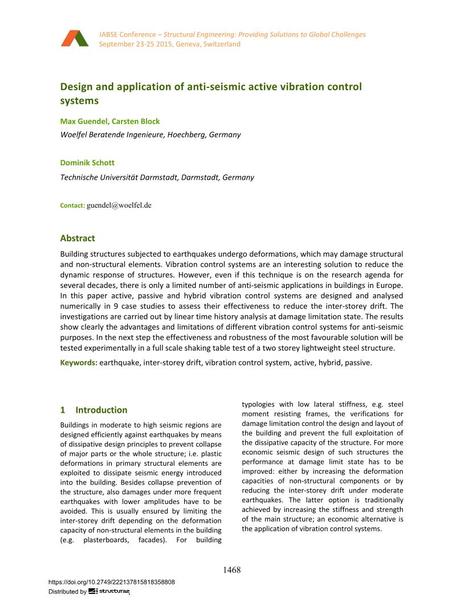Design and application of anti-seismic active vibration control systems

|
|
|||||||||||
Bibliografische Angaben
| Autor(en): |
Max Guendel
(Woelfel Beratende Ingenieure, Hoechberg, Germany)
Dominik Schott (Technische Universität Darmstadt, Darmstadt, Germany) Carsten Block (Woelfel Beratende Ingenieure, Hoechberg, Germany) |
||||
|---|---|---|---|---|---|
| Medium: | Tagungsbeitrag | ||||
| Sprache(n): | Englisch | ||||
| Tagung: | IABSE Conference: Structural Engineering: Providing Solutions to Global Challenges, Geneva, Switzerland, September 2015 | ||||
| Veröffentlicht in: | IABSE Conference Geneva 2015 | ||||
|
|||||
| Seite(n): | 1468-1475 | ||||
| Anzahl der Seiten (im PDF): | 8 | ||||
| Jahr: | 2015 | ||||
| DOI: | 10.2749/222137815818358808 | ||||
| Abstrakt: |
Building structures subjected to earthquakes undergo deformations, which may damage structural and non-structural elements. Vibration control systems are an interesting solution to reduce the dynamic response of structures. However, even if this technique is on the research agenda for several decades, there is only a limited number of anti-seismic applications in buildings in Europe. In this paper active, passive and hybrid vibration control systems are designed and analysed numerically in 9 case studies to assess their effectiveness to reduce the inter-storey drift. The investigations are carried out by linear time history analysis at damage limitation state. The results show clearly the advantages and limitations of different vibration control systems for anti-seismic purposes. In the next step the effectiveness and robustness of the most favourable solution will be tested experimentally in a full scale shaking table test of a two storey lightweight steel structure. |
||||
| Stichwörter: |
Erdbeben Hybrid
|
||||
